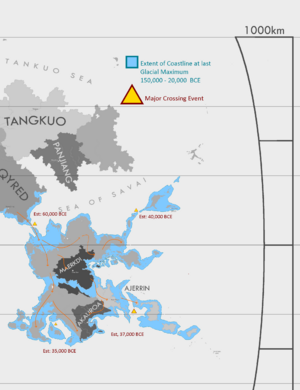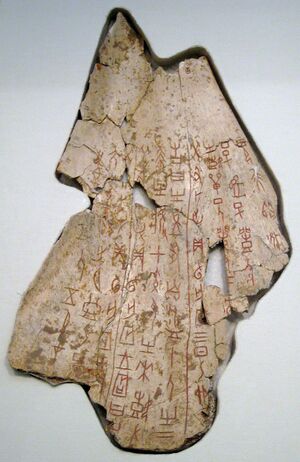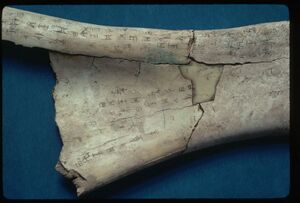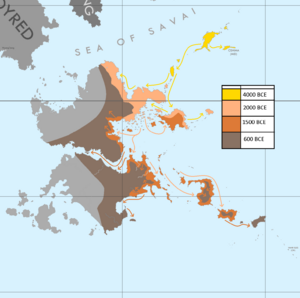Mærdki
The First Peoples
The leading theory in global migration towards the Savai continent is an extension of the Majulan costal migration model, where early people’s migration eastwards from Catai had begun to spread along the easily navigable coast. The crossover between the south of Yidao and the Northern island of Savai is dated to 60,000 BCE, where the geography of the Qyred peninsula extended into a large low-lying plain. The existence of an isthmus permitting crossing is debated, as soil-core analysis indicates under-sea landslides to have occurred between 40,000 and 70,000 BCE. This hypothesis is supported by evidence on the south-western archipelago of Savai of a mega tsunami, with debris and aquatic fossils found far inland above their time-appropriate strata. With the recent findings by the university of New Hope’s 2017 Exhibition, the elimination of the glacial ‘bounce back’ theory have paved the way for Catai, Yidanese and Majulan geologists to investigate similar cases of out-of-place fossils. While the isthmus and collapse are generally agreed upon by the anthropology community, it is not known if the isthmus is what facilitated human migration, or if early humans had crossed the gap using primitive ocean-going equipment. Though joint under-sea laser measuring expeditions are forecasted for 2025 by the universities of Lasu Duz and Oshima , no solid remains of primitive sea-faring technology has been found. The leading cause of suspicion for anthropologists however comes from the folklore and mythology of highland Maersk tribes. In the earliest documented instance of highlander folklore, elders referred to their ancestors as the “Menyiram Rukia” literally translating to “Those who run from water” in standard Navish. However, linguists from the University of Lasu Duz have suggested that this translation is inaccurate, as Highland Ardnu does not differentiate between the prepositions of ‘from’ ‘in’ ‘on’ or ‘over’. Retrospective analysis of the first and current transcriptions of Highlander folklore, have raised the possibility that the ancestral “Menyiram Rukia” refers to the first peoples that crossed from Catai 60,000 years ago, not as “Those who run from water” but instead as “Those who run on water”, with primitive sailing technology.
Haponesian Thalassocracy
While Savai was one of the last continents to be settled by mankind, it may have well been the first to discover advanced sailing technology. The ethnic and linguistic similarities between the peoples of the western and central coasts, further inland migration shows an increase of diversity as geographic separation has lead to mutations in grammar and vocabulary to the point where dialects vary from one village to the next. Archaeological evidence however points to a gradual dispersal of peoples over time from the northern peninsula and even further north from the Oshima island chain. It is speculated that the rapid rise of sea levels and the spread of disease and ensuing war among the old indigenous peoples created an environment that encouraged people to flee offshore, arriving at the gentle and lush northern peninsula. Artefacts depicting mythological figures as well as burial jars and archaic inscriptions on animal bones. The ancestry of indigenous western Savai can be traced back to the mix of two people groups, the ethnic Oshimian migrants and the mainland Hapon peoples of the peninsula. Fighting between these two people groups has been referred in the mythology of the area and is supported with evidence of flint spearheads and warrior graves characteristic of an Oshiman warrior’s burial alongside another soldier. This ancient custom died out on mainland Oshima around 37,000 BCE however became integrated into Haponesian culture as a sign of eternal protection. Usually reserved for bound lovers, battle brothers and priests with midwives. It is not known if the result of this cultural crossover was a peace between tribal groups or through forced assimilation through captured slaves, though the ruins of sacked Oshiman settlements have been found near larger Hapon villages.
Journeys over Land and Sea Savian Agricultural Revolution Thalassocracy and Pax Savinesia Classical Era Warring States period



